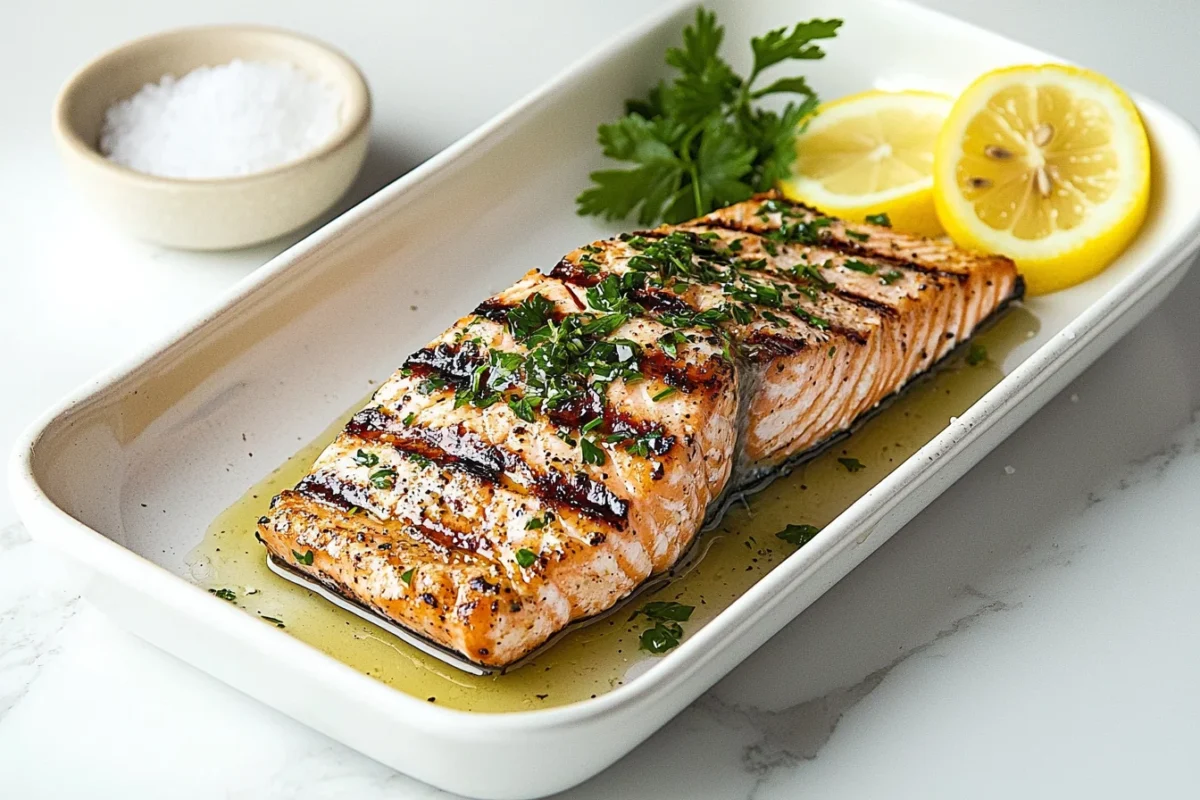Cooking king salmon can sometimes feel tricky. You might wonder how to make it flavorful without overcooking it. How should king salmon be cooked? That’s the question we’re here to answer in a simple and exciting way.
King salmon is not just another fish—it’s rich, tender, and full of omega-3s. First, it’s versatile, whether you’re grilling, baking, or pan-searing. Next, it’s a healthy choice that’s easy to prepare, even if you’re new to cooking fish. Imagine serving a dish that’s both delicious and nutritious! For more ideas on what pairs well with fish, check out What Cheese Goes Well with Canned Fish.
You’ll love how king salmon fits into any meal. It works for quick dinners or elegant gatherings, making it a must-try for everyone. We’d love to hear from you—what’s your favorite way to cook king salmon? Drop a comment below and let us know! Ready to make something truly special? Keep reading to learn the best tips and tricks for cooking king salmon. You’re just a step away from your new favorite recipe!
Table of Contents
The Perfect Way to Cook King Salmon
Why King Salmon Requires Special Techniques
King salmon is prized for its rich texture and exceptional flavor, but many still ask, How should king salmon be cooked to highlight these qualities? First, its high-fat content makes it juicy and tender, but it can quickly dry out if overcooked. This is why precision is key for this delicate fish. For delicious seafood combinations, explore What Pairs Well with Tinned Fish. Also, unlike leaner fish, king salmon thrives with slower cooking methods that allow its natural oils to enhance the flavor.
Next, choosing the right heat level is essential. High heat works well for a crispy exterior, but medium heat ensures the inside stays moist and flaky. Additionally, king salmon pairs beautifully with simple seasonings, so there is no need to overdo it. Let the fish shine!
By mastering these techniques, you can enjoy a meal that is both elegant and effortless. Ready to try it yourself? Keep reading for even more tips and ideas.
Tips for Juicy, Flavorful Results
Getting perfectly cooked king salmon is easier than you might think. First, selecting fresh or properly frozen fish is crucial. Fresh salmon has vibrant color and a pleasant, clean scent. Once you have your fish, use a thermometer to monitor the internal temperature as it cooks. This ensures you avoid dryness while keeping it juicy and tender.
Next, timing is everything. King salmon cooks quickly, so keep a close eye on it to avoid overcooking. Covering it with foil while baking or grilling can also lock in moisture. Need creative side dishes for seafood? Try some inspiration from What to Serve with Sardines. Finally, rest the salmon for a few minutes before serving to let the juices redistribute evenly.
These simple steps make a big difference in achieving flavorful results. Whether you are cooking for family or friends, this guide will help you impress every time. Try these ideas today, and you will love how easy they are!
Exploring the Best Cooking Methods for King Salmon
Benefits of Grilling for King Salmon
Grilling king salmon brings out its rich flavor while adding a delightful smoky taste. First, preheating the grill is essential to create those beautiful sear marks and prevent sticking. Then, lightly oil the grates and brush the fish with olive oil to enhance the process. This simple step locks in moisture while giving the salmon a nice char.
Next, grilling allows you to infuse flavors using wood chips or marinades. Cedar planks, for instance, can add a subtle earthy aroma that pairs perfectly with the fish. Additionally, grilling works well for quick cooking, making it ideal for busy evenings or backyard gatherings.
By grilling king salmon, you get a dish that is flavorful, healthy, and satisfying. It is a fun and easy way to enjoy this prized fish. Why not fire up the grill tonight and give it a try?
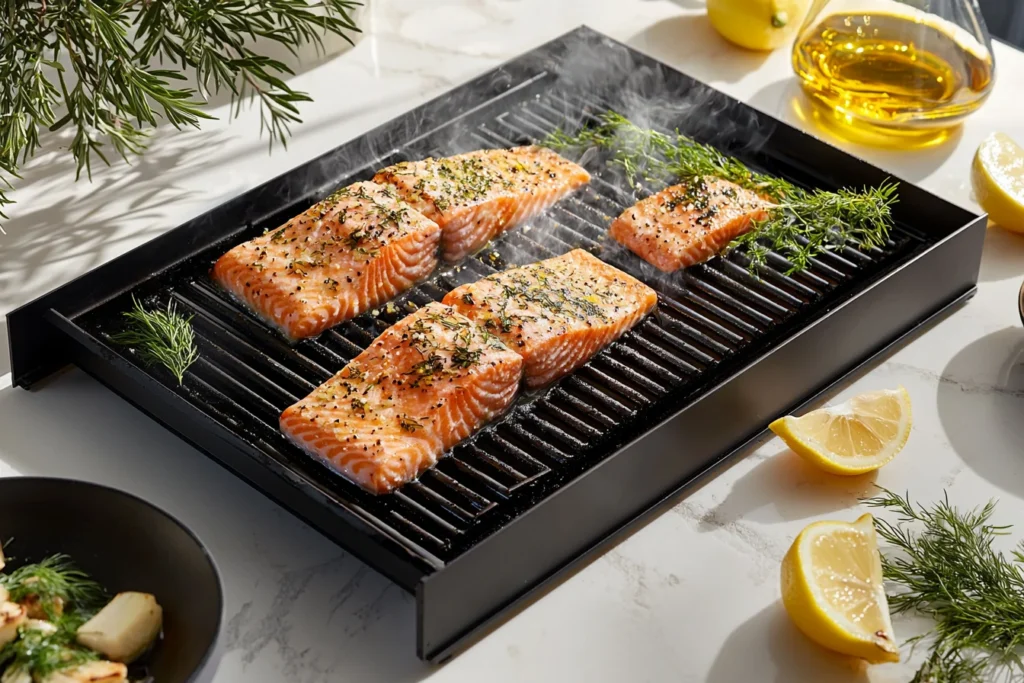
Baking for Delicious Results
Baking king salmon is a top answer to How should king salmon be cooked for perfect results every time. First, it ensures even heat distribution so the fish cooks uniformly and stays moist. Placing it on a lined baking sheet with fresh herbs, lemon slices, and olive oil creates a fragrant, juicy dish.
Next, baking is perfect for adding toppings like breadcrumbs, crushed nuts, or parmesan cheese. These flavorful additions form a delightful crust while locking in the salmon’s natural juices and enhancing its texture. Additionally, you can bake it in parchment paper or foil for a mess-free, steamed effect that enhances its tenderness.
Baking not only preserves the salmon’s nutritional value but also creates endless flavor possibilities to explore.
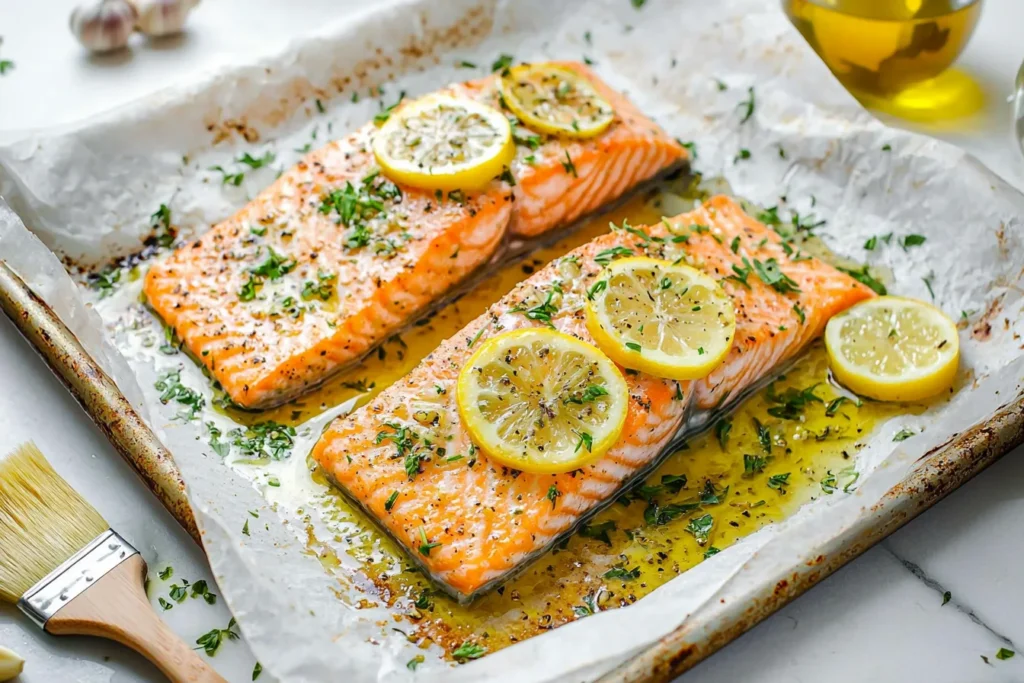
Try this method when you want a low-maintenance, delicious meal that impresses everyone. You will love how simple, customizable, and satisfying it is!
Essential Tips for Cooking King Salmon Like a Pro
Temperature Guidelines for Perfectly Cooked Salmon
Cooking king salmon to the right temperature is key to achieving a tender, juicy result. First, use a food thermometer to ensure precision and consistency every time. The ideal internal temperature for perfectly cooked salmon is around 125°F to 130°F when measured in the thickest part of the fillet.
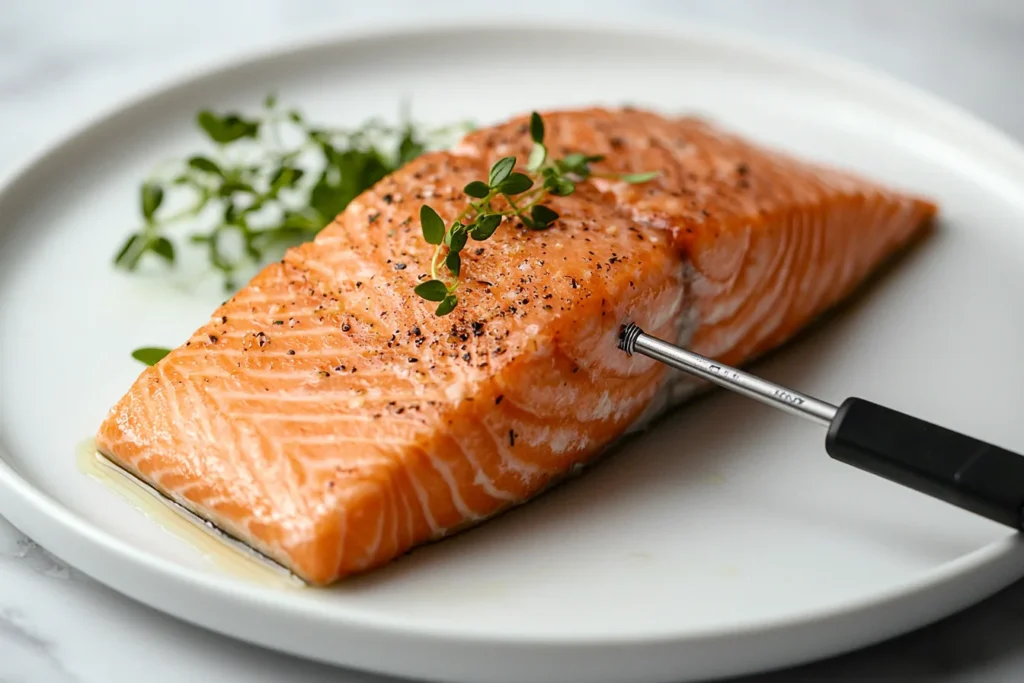
This range delivers a moist, flaky texture without overcooking. You can find more information on safe cooking temperatures for fish from the USDA.
Next, let the salmon rest for a few minutes after removing it from the heat source. Resting allows the juices to redistribute evenly, enhancing the flavor and preventing dryness. Additionally, lower heat settings, such as baking at 375°F or grilling over medium heat, help preserve its delicate texture.
Cooking king salmon to perfection is easier than you think with these simple steps. Use this guide to make every dish a success, and you’ll wow your friends and family with restaurant-quality results.
Common Mistakes to Avoid When Cooking King Salmon
Avoiding common mistakes helps answer the question: How should king salmon be cooked to always taste amazing? First, avoid overcooking, as it can dry out the fish and reduce its flavor. Pay attention to cooking times and temperatures for moist, flavorful salmon.
Next, do not skip seasoning or marinating, as these steps enhance the natural taste of the salmon. A simple marinade or spice rub can make a big difference. Additionally, avoid using high heat for too long, as it can cause uneven cooking and burned edges. Opt for moderate, consistent heat for the best results.
Finally, avoid overcrowding the pan or grill, as this can trap steam and prevent a crisp exterior. These simple tips will help you avoid common pitfalls and ensure your king salmon is always a show-stopping dish. Give them a try, and enjoy the difference they make! Do you have any tips to avoid cooking mistakes? Share your thoughts in the comments!
Enhancing Flavor: Seasoning King Salmon the Right Way
Simple Spice Blends for King Salmon
Seasoning king salmon with simple spice blends can transform it into a flavorful masterpiece. First, try a classic combination of salt, black pepper, and paprika for a smoky, bold taste. Adding a pinch of garlic powder or onion powder enhances the natural flavors without overpowering the fish.
Next, experiment with herb-based blends like dill, parsley, or thyme, which pair beautifully with the richness of king salmon. A squeeze of lemon or orange juice can brighten the dish and balance the flavors. Additionally, a light drizzle of olive oil or melted butter helps the spices adhere, ensuring an even coating.
With these easy-to-make blends, you can tailor the flavor to suit any occasion. Whether you prefer subtle or bold tastes, there’s a seasoning combination that’s perfect for your salmon. Try these ideas today, and watch your family fall in love with this versatile fish!
The Role of Marinades in Boosting Salmon’s Taste
Marinades are a fantastic way to infuse king salmon with bold, dynamic flavors. First, acidic ingredients like lemon juice, soy sauce, or vinegar tenderize the fish while adding a tangy kick. Combining these with olive oil or yogurt helps create a rich, creamy texture.
Next, flavor-enhancing ingredients like honey, ginger, or mustard can add sweetness or spice, elevating the dish. Marinades with herbs such as rosemary, thyme, or cilantro complement the fish’s natural taste and add an aromatic touch. Let the salmon soak in the marinade for 30 minutes to an hour for optimal flavor absorption.
Using marinades is an effortless way to customize your dish for any meal or event. Whether you’re preparing a casual dinner or an impressive feast, a good marinade ensures your king salmon is always full of delicious flavor. Give it a try and savor the difference!
How Cooking Techniques Affect King Salmon’s Nutritional Value
Retaining Omega-3 Fatty Acids in King Salmon
Preserving omega-3 fatty acids in king salmon is essential for maximizing its health benefits. First, cooking methods like steaming or baking at moderate temperatures are ideal for retaining these valuable nutrients. These techniques ensure the salmon cooks evenly without exposing it to excessive heat that can break down omega-3s.
Next, avoid overcooking, as this can cause a loss of both flavor and nutritional value. For instance, steaming king salmon with vegetables or baking it in foil allows the fish to retain its natural oils and nutrients. Additionally, using minimal seasoning or sauces enhances the dish without overshadowing its natural goodness.
By choosing gentle cooking methods and watching the time, you can ensure every bite of your king salmon is both healthy and delicious. Try these tips to enjoy the full nutritional potential of this flavorful fish!
Health Benefits of Different Cooking Styles
Different cooking styles impact the nutritional value of king salmon in unique ways. First, grilling adds a smoky flavor while keeping the calorie count low, provided you use minimal oil. Baking is another healthy option, as it allows the fish to retain moisture and nutrients while creating a delicious crust.
Next, poaching king salmon in a flavorful broth is perfect for those seeking a low-fat cooking method. This technique keeps the fish tender while preserving its natural oils and omega-3 fatty acids. Additionally, steaming offers a similar benefit, ensuring the fish’s texture remains delicate and its nutrients are locked in.
Each cooking style offers a unique way to enjoy king salmon while keeping it nutritious and tasty. Whether you prefer grilled, baked, or steamed, you can confidently enjoy the health benefits of this versatile fish. Try exploring these methods to find your favorite!
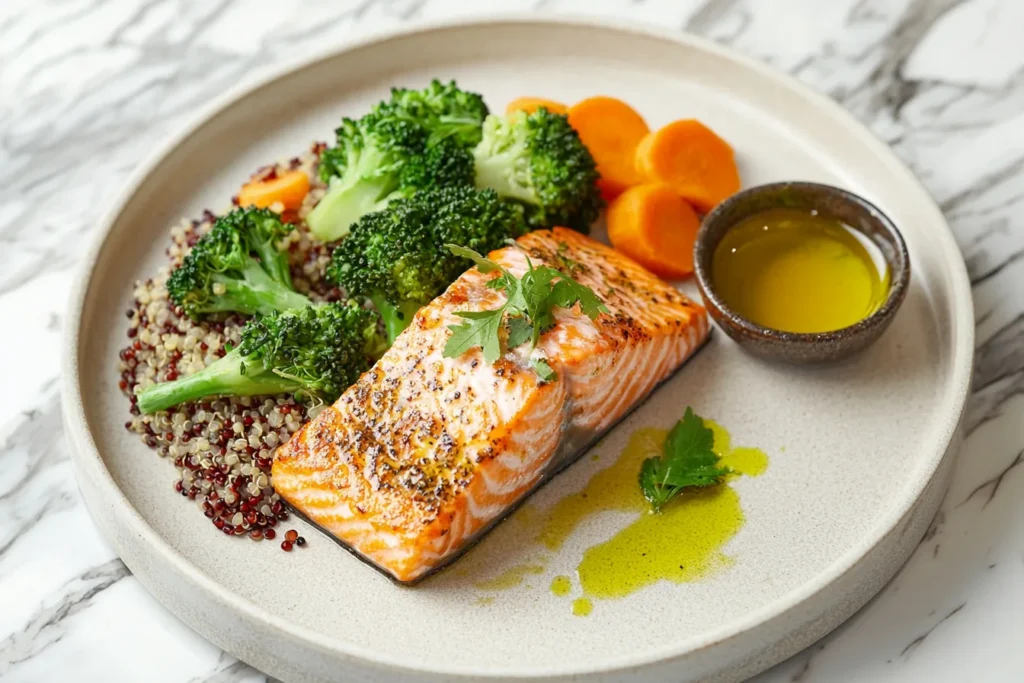
Preparing King Salmon for Cooking Success
Proper Thawing and Cleaning Techniques
Proper thawing and cleaning are essential steps to prepare king salmon for cooking success. First, thaw frozen salmon in the refrigerator overnight for the best results. This slow method ensures even thawing, preserving the texture and flavor. If you’re in a rush, place the sealed salmon in a bowl of cold water, changing the water every 30 minutes.
Next, cleaning the salmon thoroughly is crucial. Rinse it under cold water and gently pat it dry with a paper towel. If your salmon has skin, use a sharp knife to remove any remaining scales, scraping lightly in the opposite direction of the scales. Additionally, check for small pin bones by running your fingers along the fillet and removing any with kitchen tweezers.
By taking these simple steps, you’ll ensure your king salmon is clean, fresh, and ready to cook perfectly. Try this for better-tasting results every time!
Slicing and Portioning for Consistent Cooking
Slicing and portioning king salmon correctly makes a big difference in achieving even cooking. First, use a sharp knife to cut the fillet into uniform pieces, ideally about one to two inches thick. Uniform sizing helps the salmon cook evenly and ensures every piece is juicy and tender.
Next, consider the recipe you’re following when portioning. For grilling, keep the pieces larger to prevent them from breaking apart. For stir-fries or soups, smaller cubes work well for quicker cooking. Additionally, leave the skin on if you plan to grill or sear the salmon, as it helps retain moisture and adds flavor.
These tips for slicing and portioning make cooking king salmon easier and more consistent. Whether preparing a large fillet or smaller servings, taking the time to portion correctly will elevate your cooking experience. Give it a try and enjoy better results!
Frequently Asked Questions (FAQs)
What’s the best way to cook king salmon?
The best way to cook king salmon depends on your taste and time. First, grilling king salmon is a popular choice. The smoky flavor pairs perfectly with its rich taste. Baking is another fantastic option. It is simple, requires little effort, and keeps the salmon juicy.
Next, pan-searing gives the fish a crisp, golden crust while locking in moisture. This method works great for quick dinners. For a healthier twist, steaming is ideal. It preserves nutrients and keeps the texture tender. No matter the method, king salmon’s flavor shines when cooked carefully. You’re going to love how versatile it is!
What is the best method to cook salmon?
The best method to cook salmon depends on your preferences and the dish you’re making. First, baking is excellent for achieving tender, flavorful salmon with minimal effort. It works well with seasonings and toppings like herbs or breadcrumbs.
Next, grilling gives salmon a smoky, charred flavor that enhances its richness. It’s perfect for summer meals. For a quick option, pan-searing creates a crisp outer layer while keeping the inside moist. Additionally, steaming is a healthy method that locks in nutrients and maintains a soft texture. Try experimenting to find your favorite way to cook salmon!
Should salmon be cooked medium or well-done?
Salmon is best cooked to medium for the perfect balance of flavor and texture. First, medium-cooked salmon is moist, tender, and packed with flavor, while still being fully safe to eat. The internal temperature should reach about 125–130°F, giving it a slightly pink center.
On the other hand, cooking it well-done can make it dry and less enjoyable. However, if you prefer well-done salmon, aim for an internal temperature of 140°F to maintain some moisture. Ultimately, it depends on your personal taste, but medium is a great choice for most people!
How to tell if king salmon is cooked?
You can tell king salmon is cooked by checking its texture and color. First, properly cooked salmon flakes easily with a fork. Its flesh turns from a translucent pink to an opaque light pink, signaling it’s done.
Next, you can use a food thermometer for accuracy. The salmon’s internal temperature should reach 125–130°F for medium or 140°F for well-done. Additionally, the edges may appear slightly firmer than the center. If you gently press it, cooked salmon will feel firm but still slightly springy. These simple steps ensure perfect results every time!
Bring the Best Out of King Salmon with These Cooking Tips
Cooking king salmon perfectly is simpler than you might think. With the right methods, you can create meals that are flavorful and satisfying. First, whether you bake, grill, or sear, each technique offers unique benefits. King salmon’s rich taste and tender texture shine when cooked with care and creativity.
Next, remember that preparation and seasoning are just as important as cooking. Properly thawing, cleaning, and portioning the salmon sets the stage for consistent results. Additionally, experimenting with marinades, spices, or simple herbs can boost its natural flavors. Do not be afraid to try something new—cooking salmon is fun and rewarding!
Finally, no matter how you prepare it, king salmon is a healthy and delicious option for any meal. Its versatility makes it ideal for quick dinners or special occasions. So, grab some salmon, follow these tips, and enjoy the satisfaction of cooking it perfectly. We’d love to hear your feedback—leave a comment and share your favorite way to enjoy king salmon!

